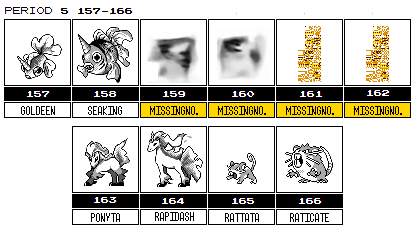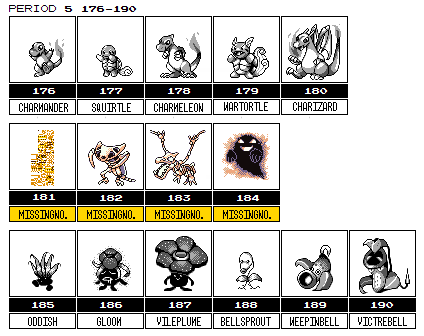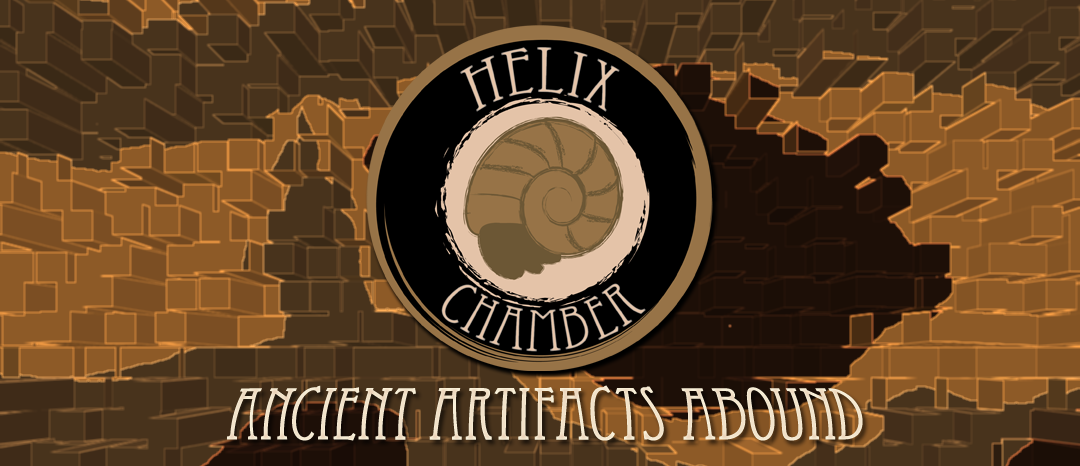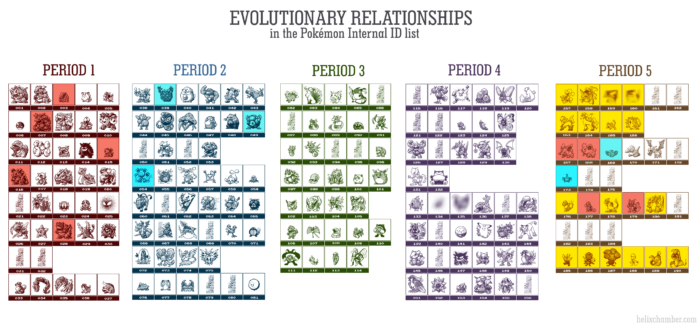By the time that Period 5 started, the Kanto overworld was most likely similar to the final game. The drastic change, both in the games’ environment and design choices, began in Period 3; many of the Period 1 and Period 2 Pokémon became uncommon, relegated to the Safari Zone, or made extinct in order to make room for the more friendly looking fauna. In Period 4, the creators exclusively focused on expanding on previous concepts, so by Period 5 they realized that the routes were a little bare and still in need of new inhabitants.
| ⇐ | INTRO | P1 | P2 | P3 | P4 | P5 | ⇒ |
| MISSINGNO. OVERVIEW | LOST POKEMON OVERVIEW | ||||||
PERIOD 5
Period 5 (ID 157 – 190, Goldeen – Victreebell), is the sole monolithic period in our research. We didn’t split it into any sub-periods, because it’s so varied that it would be more convenient to go through each pattern one by one… with the hope that some future reveal will help us get a better understanding of the underlying patterns.
 ID 157-166 (Goldeen – Raticate) is structured similarly to Period 3a (entire two-stage lines added one after another) but with a kind of a Period 2b ecosystem awareness and purpose to populate the final locations.
ID 157-166 (Goldeen – Raticate) is structured similarly to Period 3a (entire two-stage lines added one after another) but with a kind of a Period 2b ecosystem awareness and purpose to populate the final locations.
Mundane creatures based on recognizable real-life animals, each of these lines also has a straightforward elemental (Ponyta’s fire) or anatomical (Goldeen’s horn) twist. We already know that MissingNo. 159 and 160 are Kotora and Raitora, as seen in the GCCX “Kaiju Index”, so we can assume that MissingNo. 161 and 162 were a two-stage family designed with the same principles.
Following that group, we meet an odd collection of monsters. First there is Nidorino and Nidorina, completing their respective evolution lines that go all the way back to Capumon. After that, ID 169-173, is a seemingly random assemble dedicated to fine-tuning some monster-collecting aspects of the game. Sadly, there are too many missing Pokémon to discern a pattern. One key could be a shared inorganic quality between Geodude, Porygon, Aerodactyl and Magnemite. Alternatively, just like Geodude and Magnemite, some of the MissingNo. could have been pre-evolutions of already designed Pokémon, especially the ones created in Period 2.

The final part of the list (ID 176-190, Charmander – Victreebel) finally introduces two starters, Charmander and Squirtle lines, a bunch of MissingNo. including the skeleton and ghost sprites, and then the version exclusive Grass types. We’ll start with the latter ones, as they could indicate that split into two versions wasn’t conceptualized until very late into development.
Atsuko Nishida is credited with designing all of the legitimate Pokémon in this section. (Some of these have been previously widely unknown as her work; an interview on Game Freak’s website has an old interview with Nishida that listed all of these Pokémon as her designs.) She was probably assigned to do all of this block, for one reason or another.
Firstly, the Grass-types: the Leaf Stone was seemingly a late addition to the item list, and may have encouraged the designing of more Grass-type evolutionary lines. The roster already featured Grass types as early as Period 1a, but they became increasingly sparse throughout the rest of the design process. These two lines were probably created to compensate for the general lack of Grass-types in the game.
An important thing to note is that the Bellsprout and Oddish lines are among the most common Pokemon in their respective versions, populating most of the eastern routes of Kanto. Seeing as they are very late additions, and those locations must have been populated at least since Period 2b, questions naturally arise – what was dwelling on these routes before Oddish and Bellsprout? Could their abundance compensate for some losses? More Grass-types among the MissingNo. might also explain why Generation I only has one pure Grass-type.
The starter portion of the index list might be the most interesting one. Bear with us: things are going to get technical.
Sugimori stated that the idea of having starters of three different types came about halfway through development. Since Charmander, Squirtle, and their evolutions (excluding Blastoise) are very late in the index list, this could mean that other Pokémon may have been considered as starters at one time or another, and Charmander and Squirtle’s lines were added later on as more defined “starter” types. One compelling idea is that Nidoran♂ and Nidoran♀ were originally meant to be the starters, seeing how much emphasis was given to them in Capumon – they had evolutionary relatives and gender counterparts very, very early into development.
Prior to P5, the Bulbasaur line had already been finished (in Period 4b), but whether or or not it was originally designed to be a starter is unknown. Its status as an outlier is emphasized by the fact that the Charmander and Squirtle lines mirror each other’s stats (for example, Charmander’s base Speed is Squirtle’s base Defense), while Bulbasaur’s line is just a variation with the same values, and doesn’t coincide with the other two’s stats.
The Charmander and Squirtle lines aren’t just similar stats-wise; their index numbers are placed in an intertwining pattern, ending at Charizard at 180. Blastoise was designed as one of the first Pokémon, so obviously it’s absent from P5; otherwise it would almost certainly occupy spot 181. Evidence suggests that there was a connection between Blastoise and whatever was in slot 181 – a dastardly switcheroo of sorts may have taken place.
If you refer to the cry list, you can see that the entire Charmander line uses a single base cry (0x04, based on Rhyhorn – and in Charizard’s case, identical to it), but in the case of the Squirtle line, Blastoise uses a completely different base cry.
Additionally, each stage of their respective lines use the same parameters for pitch and length, so Charmander and Squirtle, although they use different base cries, both use pitch and length values of 96 and 64; the same thing occurs with Charmeleon and Wartortle, both of which have their parameters at 32 and 64. While both Charizard and Blastoise have the supposed default cry values, 0 pitch and 128 length, Blastoise uses a base cry that is different from the one that its pre-evolutions use.
MissingNo. 181, placed right after Charizard, just so happens to be one of the few MissingNo. to have unique cry data intact. MNo. 181 has the same base cry as Squirtle and Wartortle, with the same pitch and length parameters as Charizard. This suggests that Blastoise may have occupied that spot or belonged there at one point, or perhaps 181 was its own Pokémon?
Another thing to consider is that immediately after Charizard, but before the two plant lines, there are four MissingNo., three of which (182-184) are occupied by MissingNo. with the Ghost and fossil skeleton sprites. ![]() If the above hypothesis is true, then the three MissingNo. with unique sprites may have constituted another full three-stage line like the plant lines that follow it; or that the series of four MissingNo. slots was occupied by two different two-stage lines. The varied nature of this period makes any combination possible, even the more mundane suggestion that 182-184 were never supposed to be playable Pokémon and their slots were just used as an easy way to design and display the sprites – and then a couple more Pokémon were placed in after them.
If the above hypothesis is true, then the three MissingNo. with unique sprites may have constituted another full three-stage line like the plant lines that follow it; or that the series of four MissingNo. slots was occupied by two different two-stage lines. The varied nature of this period makes any combination possible, even the more mundane suggestion that 182-184 were never supposed to be playable Pokémon and their slots were just used as an easy way to design and display the sprites – and then a couple more Pokémon were placed in after them.
And so with this final group of monsters ends our journey through the index list of the first Pokémon games. It’s quite remarkable how a simple list, ordered in a seemingly random manner, can tell a story of a rough five-year long development period; how each new idea brought to the table leaves a trace so tangible. We usually take Pokémon for granted. Evolutions, types, the inspirations – fans of the series know these things by heart, but very few examine the thought processes behind them.
We hope that our research gave you a framework to discover the Generation I games anew and, through this digital archaeology, that you’ve learned something new about the development of these games.Maybe you realized that there were some relationships between Pokémon that aren’t so evident in the final games? Maybe you’ve got an idea of what some of the MissingNo. could have been?
The research will continue, and hopefully, we can learn more about the mysteries of the development of Pokémon Red and Green from the creators themselves in the foreseeable future.
On that note, our work is not yet finished, and we still have some ground to cover. Join us in the next article where, based on the patterns we discussed, we provide our own speculative guesses as to what Pokémon might have existed on the MissingNo. slots prior to their deletion.
WHERE TO GO FROM HERE, UNRESOLVED MYSTERIES
- Has Sugimori scrapped the MissingNo. from his famous Gen 1 set of official art? Does that art still exist?
- When did the split into two different game versions happen? When were the first version exclusive Pokémon intentionally designed?
- When and why was the Pokédex order created, as opposed to the index order?
- When was the name changed from “Capsule Monsters” to “Pocket Monsters”?
- Why are Period 1 Pokémon listed in the cry list order in the 1993 Poll Entries sheet and in the Game Informer document?
Visit our Library for more notes, sources and media!
| ⇐ | INTRO | P1 | P2 | P3 | P4 | P5 | ⇒ |
| MISSINGNO. OVERVIEW | LOST POKEMON OVERVIEW | ||||||



From the 2018 Pikachu interview:
Nishino:“A Pokémon’s number in the Pokédex is approximately the order that it appears in the game. This is so they don’t suddenly jump in number as the player advances through the game filling up the Pokédex.”
I think this should answer the “why” part of the Pokédex order, but not the “when” part.
157-166 Actually has 3 3-stage lines, as it starts at 156 (with baby Goldeen), then next is the evolution of the tigers and finally baby Ponyta. Rattata and Raticate are outliers, so I’d group them into:
5a 156-166 – Mostly 3-stage lines, with one 2-stage line.
5b 167-175 – Adding onto Pokémon lines from previous periods, as well as a few Pokémon that can’t evolve.
5c 176-190 – Adding starters, overworld anomalies and 2 more 3-stage lines.
Poor Pokémon 181. 🙁 I always liked Wartortle more than Blastoise.
With the Oddish and Bellsprout families so close to Squirtle and Charmander, maybe they were designed as possible candidates for the grass starter. Then Bulbasaur was reassigned as the grass starter, and these two families were kept and used to flesh out the grass types and use the leaf stone.
It is a lot of fun to speculate on what was going on with the design process.
It is! Well our current theory is that the section Oddish-Victreebel is actually an afterthought and might’ve been added very late in development possibly after the Mno. cut, perhaps the PM Kaiju Zukan could solve this mystery 😀 let’s pray the great Baloonda orb it will leak ù.u cheers!
My hypothesis is that Nishida’s two grass lines (Oddish/Bellsprout) which appear at the very end of the list were added as cute grass/poison substitutes for Bulbasaur, specifically for players who did not choose Bulbasaur as their starter.
Unlike some earlier Pokemon where a three-stage evolution was cut to two to save space, the developers at this late stage could be confident that there was room to add a final six Pokemon.
The fire types Growlithe and Vulpix similarly serve as stone-evolving fire alternatives to Charmander. In both cases, those Pokemon are edition-exclusives, suggesting that perhaps Growlithe/Vulpix were the mechanical inspiration for Oddish/Bellsprout in this regard.
It’s interesting that both Growlithe and Vulpix have empty slots before them, as well as featuring deleted pre-evolutions in the Gold/Silver prototype, as if three-stage evolutions mirroring the starters were intended or considered.
Water types are common, so that type did not need similar special treatment.
Why there are not #134 and #135 ?
I think the Lavender Ghost was intended to be its own Pokémon entirely, and not the ghost of Gastly/Haunter/Cubone/Marowak. The Skeleton Kabutops and Aerodactyl may have been originally concieved of as evolutions to Kabutops and Aerodactyl that could have replaced their Water typing with a Ghost typing. Plus, I think the Charmander and Squirtle lines overwrote different starter Pokémon. The lost Pokémon from the SW ’97 demo Cruise, Aqua, and Aquarius are a possibility for the original Water Starters